Aruba is a small Caribbean island located just off the coast of Venezuela, and it is home to some of the most unique and interesting bird species in the world.
From vibrant parrots to seabirds, Aruba’s bird species are an interesting mix of tropical and migratory birds. The island’s location and climate provide ideal conditions for these species to thrive, making birdwatching in Aruba a popular pastime.
With its diverse array of birds, Aruba is a paradise for bird-lovers and is a great place to get a glimpse of some of the most beautiful birds in the Caribbean.
1. Brown Pelican
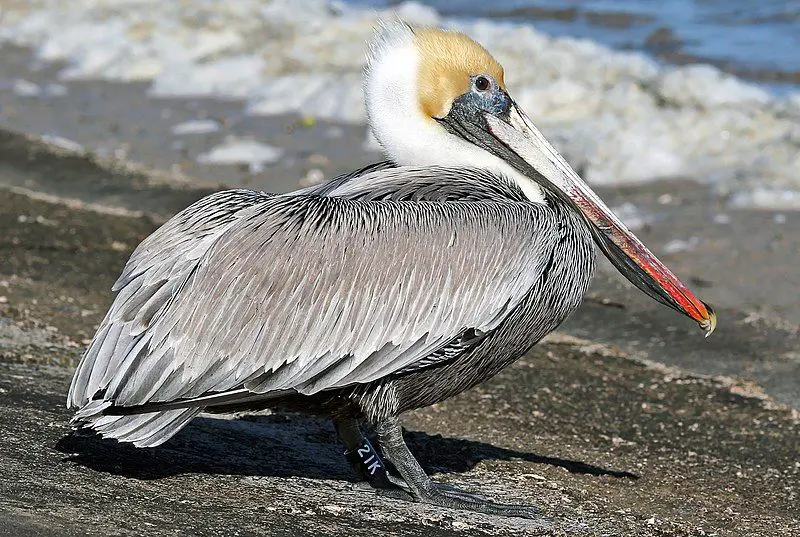
The Brown Pelican is a large seabird that can be found along the coastlines of North America. It has brown and white plumage, with long wings and a distinctive pouch under its bill for scooping up fish from the water’s surface.
The pelicans are quite social birds and often travel in flocks to feed together on small schools of fish.
They have an impressive wingspan which allows them to soar gracefully through the air, while their webbed feet help keep them afloat when they dive into the ocean below seeking food.
While these birds may look clumsy at times due to their size, they are actually very agile flyers who use their remarkable talents to capture prey quickly before returning back into flight again.
2. Crested Bobwhite
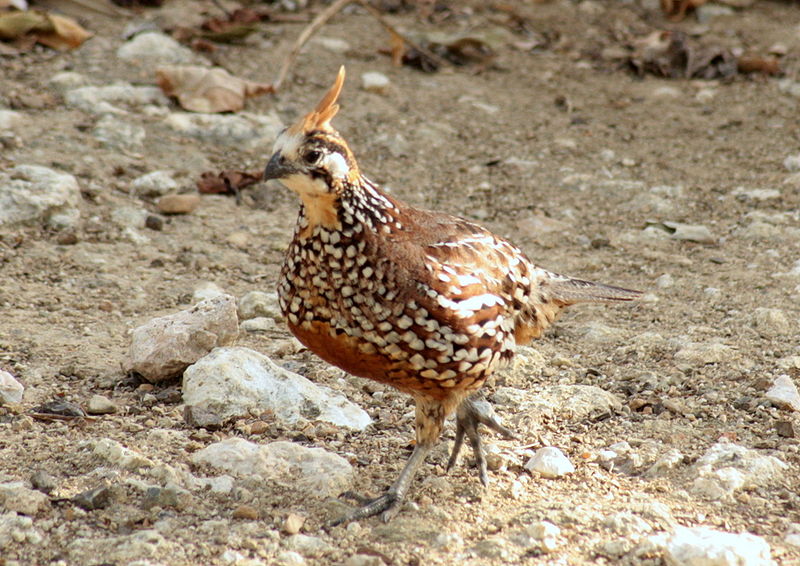
The Crested Bobwhite is an impressive bird found in Northern South America, Panama and Costa Rica. It also has been spotted on Aruba and the Netherlands Antilles.
Its habitat consists of subtropical or tropical dry shrubland, seasonally flooded lowland grasslands, as well as heavily degraded former forests.
This species can be identified by its distinctive crest which it gives them their name; they also have a black throat with white stripes running along each side of the neck.
The males are larger than females and both have speckled brown feathers all over their body with some barring near the tail end.
They feed mainly on seeds but will take insects when available too.
In general they keep to themselves but during breeding season form monogamous pairs that might stay together for several years at a time.
All in all this is an amazing creature that deserves more recognition.
Scientific classification:
| Kingdom | Animalia |
| Phylum | Chordata |
| Class | Aves |
| Order | Galliformes |
| Family | Odontophoridae |
| Genus | Colinus |
| Species | C. cristatus |
3. Blue-Tailed Emerald
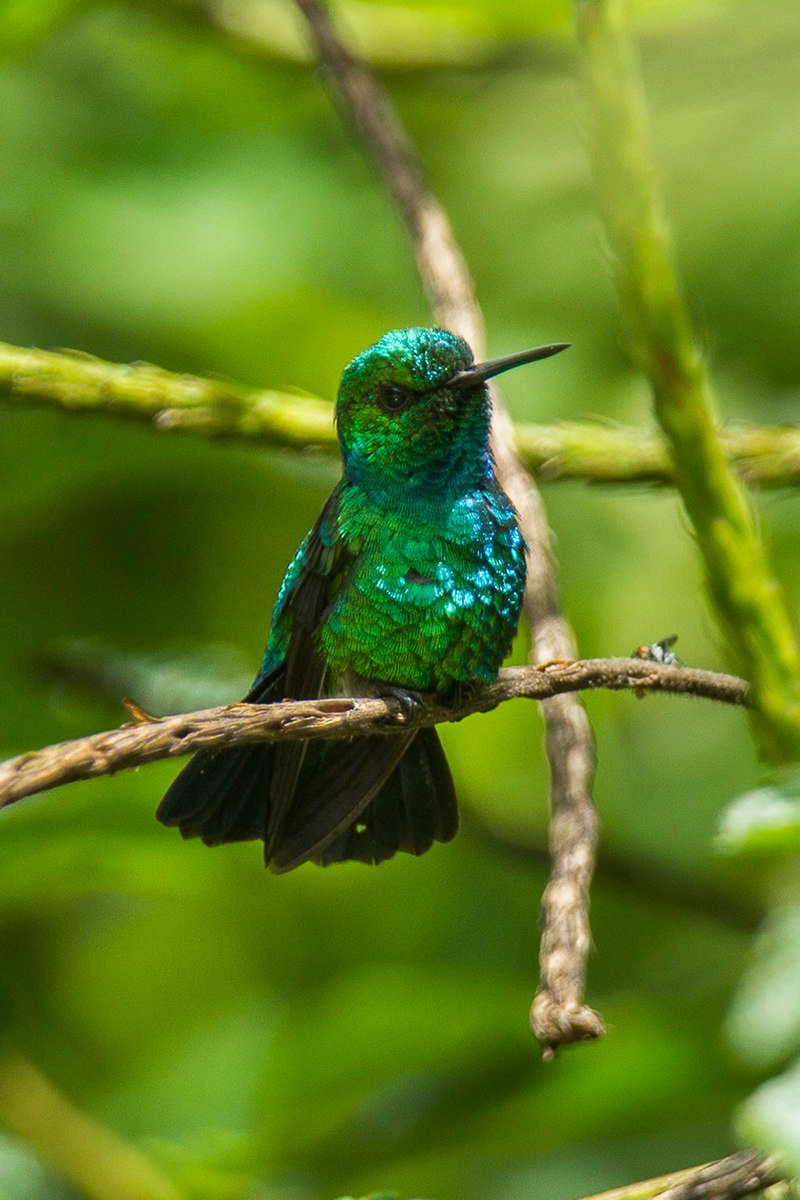
The Blue-tailed Emerald is a beautiful and vibrant hummingbird that is found in tropical and subtropical parts of South America. This species has bright green feathers, with the male having an iridescent blue tail.
These birds can be seen foraging among small flowers to collect nectar or catching insects on the wing. They are considered one of the smallest bird species, measuring at around 4 inches long from head to tail tip.
The Blue-tailed Emerald lives primarily east of the Andes Mountains from Colombia down through northern Bolivia and central Brazil, as well as Trinidad and other areas within its range such as Guianas.
It was first described by Swedish naturalist Carl Linnaeus in 1758 who noted its unique beauty compared to other birds.
Scientific classification:
| Kingdom | Animalia |
| Phylum | Chordata |
| Class | Aves |
| Order | Apodiformes |
| Family | Trochilidae |
| Genus | Chlorostilbon |
| Species | C. mellisugus |
4. Roseate Spoonbill
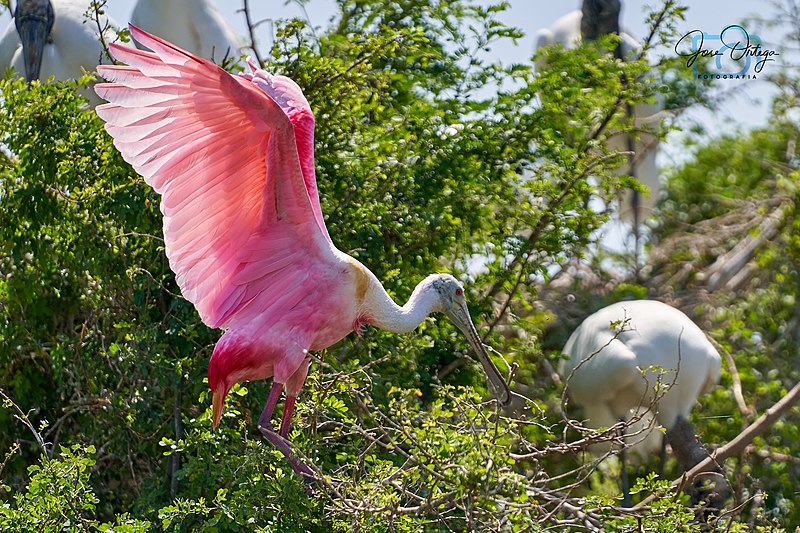
The Roseate Spoonbill is a beautiful and majestic bird found in both North and South America.
It belongs to the ibis family, Threskiornithidae, and its vibrant pink colour comes from canthaxanthin pigment derived from their diet of crustaceans like shrimp.
Sadly plume hunting has almost driven this species close to extinction during the 18th and 19th centuries but fortunately it’s making a comeback due to conservation efforts made by dedicated wildlife organisations.
Its large spoon-like bill helps them filter out food sources such as small fish or frogs from shallow water areas while they wade through mudflats with their long legs looking for something tasty.
With its unique appearance, graceful wingspan amd impressive flight capabilities, the Roseate Spoonbill is an incredibly photogenic animal that will captivate any viewers attention who happen to be lucky enough witness it in all its glory.
Scientific classification:
| Kingdom | Animalia |
| Phylum | Chordata |
| Class | Aves |
| Order | Pelecaniformes |
| Family | Threskiornithidae |
| Genus | Platalea |
| Species | P. ajaja |
5. Northern Scrub Flycatcher
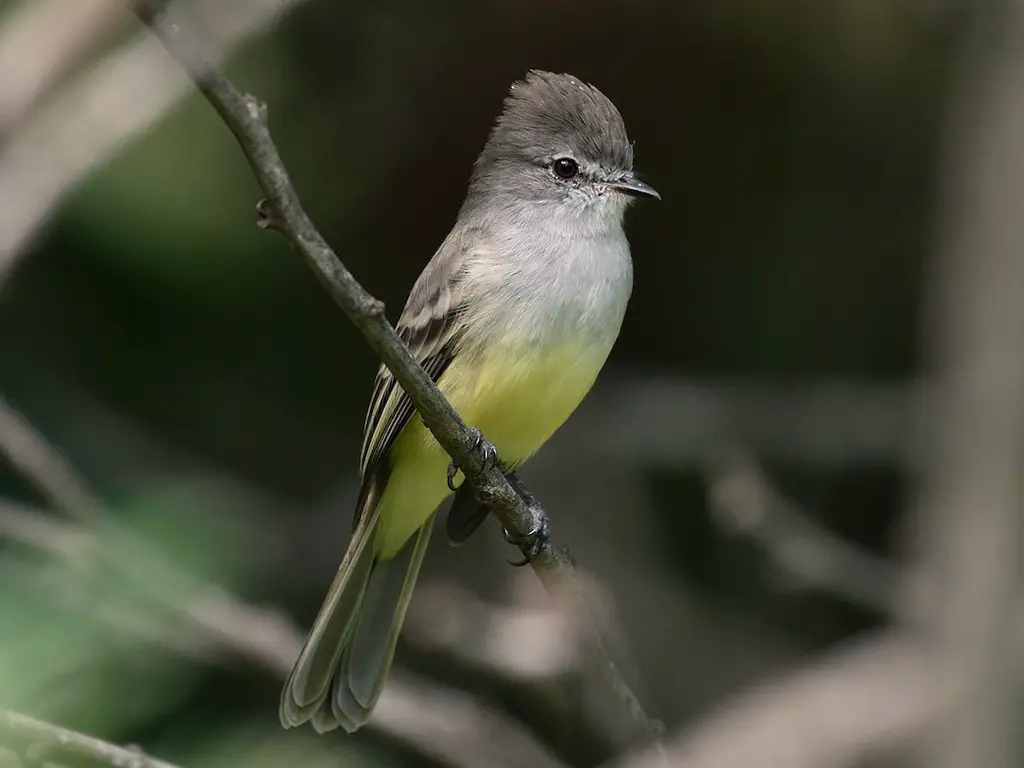
The northern scrub flycatcher is a species of bird found in various areas across South and Central America. It has a predominantly brown body with darker markings on its wings, tail and head.
This small bird typically measures around five inches long and can be identified by its distinctively large bill which is used to catch insects like flies, mosquitoes and other invertebrates.
Its habitat consists of dry forests, moist lowland forests as well as mangrove forests giving it plenty of food sources to choose from throughout the year.
The northern scrub flycatcher usually makes nests out twigs or grasses high up in trees making them safe from potential predators on the ground level such as snakes or cats.
Despite their wide range they are still considered vulnerable due primarily to human activities such deforestation for agriculture or cattle ranching that threaten not only this species but many others living amongst these habitats too.
Scientific classification:
| Kingdom | Animalia |
| Phylum | Chordata |
| Class | Aves |
| Order | Passeriformes |
| Family | Tyrannidae |
| Genus | Sublegatus |
| Species | S. arenarum |
6. Collared Plover
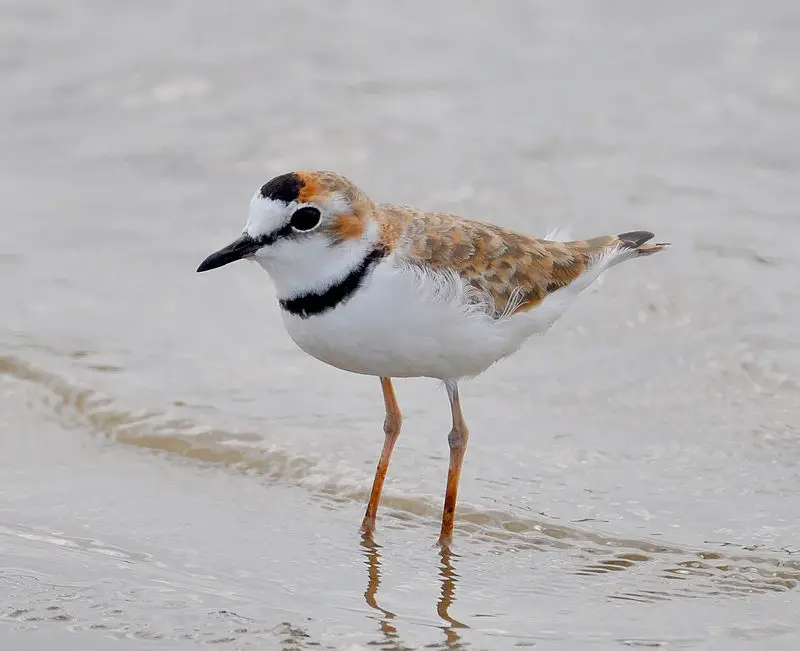
The Collared Plover is a small shorebird found along coasts and riverbanks of the tropical to temperate Americas, from central Mexico down to Chile and Argentina.
This plover measures 18 cm in length with an average weight of 35g; it has brown upperparts contrasting with white underparts all year round.
The adult plumage shows a black breast patch that can be seen clearly when they fly away or take off.
Although their population is decreasing due to habitat destruction, these birds have adapted well by learning how to live near human settlements where food sources are more plentiful.
They feed on insects, larvae, worms and other invertebrates while searching for them among mudflats, beaches or riversides.
Scientific classification:
| Kingdom | Animalia |
| Phylum | Chordata |
| Class | Aves |
| Order | Charadriiformes |
| Family | Charadriidae |
| Genus | Charadrius |
| Species | C. collaris |
7. Venezuelan Troupial
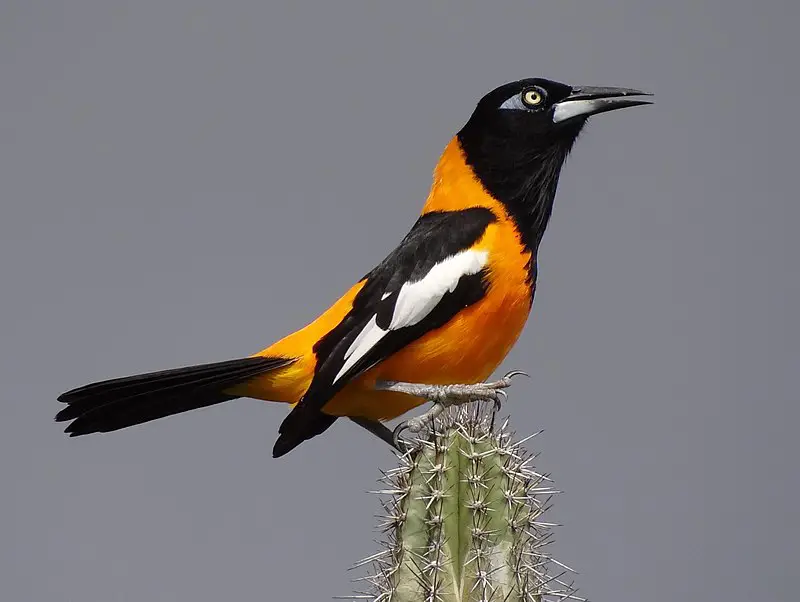
The Venezuelan troupial (Icterus icterus) is Venezuela’s national bird and can be found in Colombia, Venezuela and some Caribbean islands such as Aruba, Curaçao, Bonaire, Trinidad and Puerto Rico.
It was previously part of a superspecies known simply as the troupial with the orange-backed troupial and Campo troupial but has since been split off.
The name ‘troupial’ comes from French ‘toupiare’, which means “troop” due to their tendency to gather in flocks outside of breeding season.
They are medium sized birds with males being slightly larger than females – both have black bodies that contrast against a bright yellow head or crest.
Their wingspan averages at around 35cm long making them quite agile flyers when they migrate each year between November to April for warmer climates.
Scientific classification:
| Kingdom | Animalia |
| Phylum | Chordata |
| Class | Aves |
| Order | Passeriformes |
| Family | Icteridae |
| Genus | Icterus |
| Species | I. icterus |
8. Bananaquit
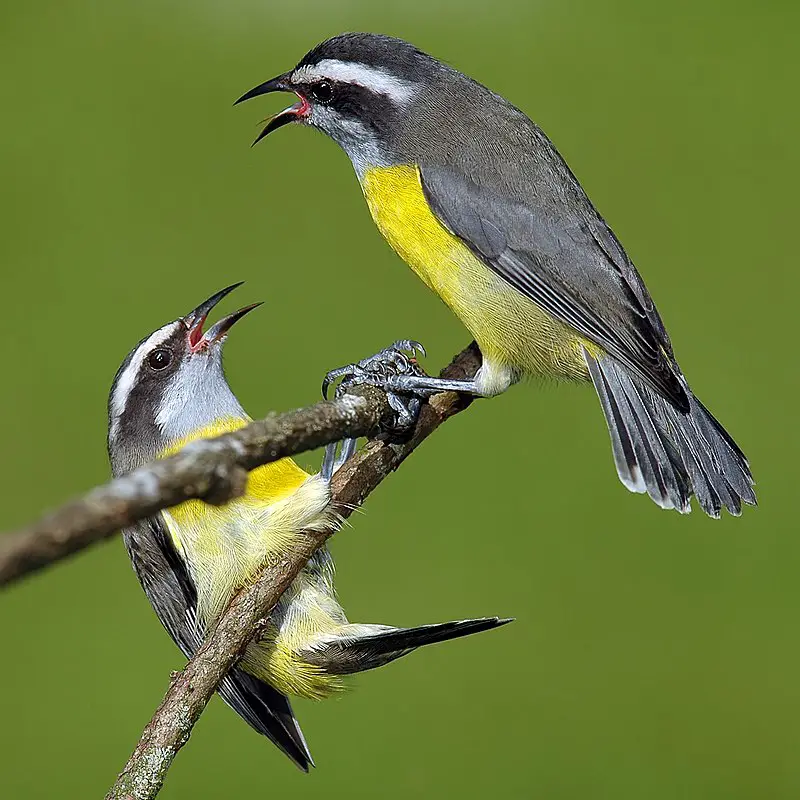
The Bananaquit, scientifically known as Coereba flaveola, is a small passerine bird belonging to the tanager family Thraupidae.
It was previously classified in either its own monotypic family or with other species such as buntings and New World sparrows (Emberizidae) or warblers (Parulidae).
This beautiful little bird has a yellow-green upper body, pale grey head and chestnut brown wings.
Its tail feathers are blackish while its belly is white with some faint streaks of olive green coloration.
The bananaquit can be found across Central America and the Caribbean islands where it feeds on fruits like bananas for which it gets its name from.
Scientific classification:
| Kingdom | Animalia |
| Phylum | Chordata |
| Class | Aves |
| Order | Passeriformes |
| Family | Thraupidae |
| Genus | Coereba Vieillot, 1809 |
| Species | C. flaveola |
9. Crested Caracara
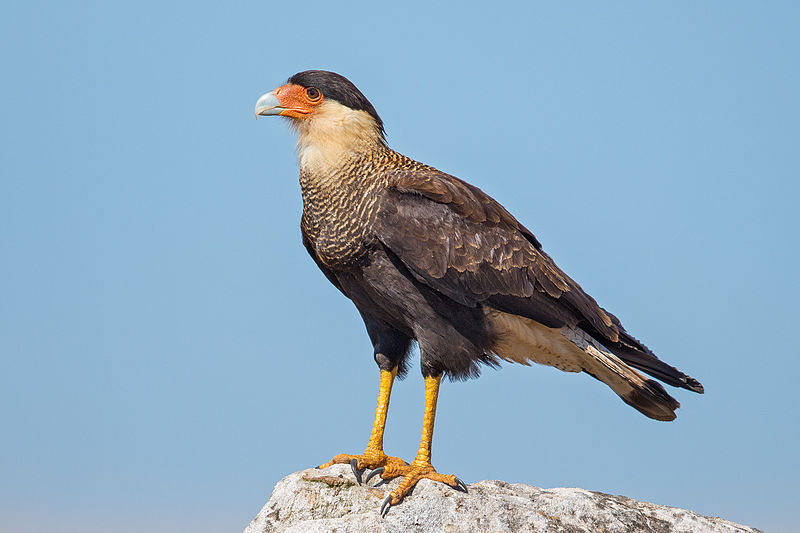
The Crested Caracara is a majestic bird of prey found from the Southern United States through Central and South America, all the way down to Tierra del Fuego.
It has an impressive wingspan ranging from 120-132 cm, with adults averaging 1,348 g in weight. This species is known for its characteristic crest on top of their head that can be raised when they are alarmed or excited.
They have pale yellow legs and feet along with dark brown feathers covering most of their body.
The Crested Caracara feeds mainly on carrion but will also take live food such as small mammals, reptiles and birds as well as garbage if it’s available near them.
These amazing raptors form strong family bonds between siblings which often last until adulthood; making them one of nature’s most remarkable creatures.
Scientific classification:
| Kingdom | Animalia |
| Phylum | Chordata |
| Class | Aves |
| Order | Falconiformes |
| Family | Falconidae |
| Genus | Caracara |
| Species | C. plancus |
10. Black Skimmer
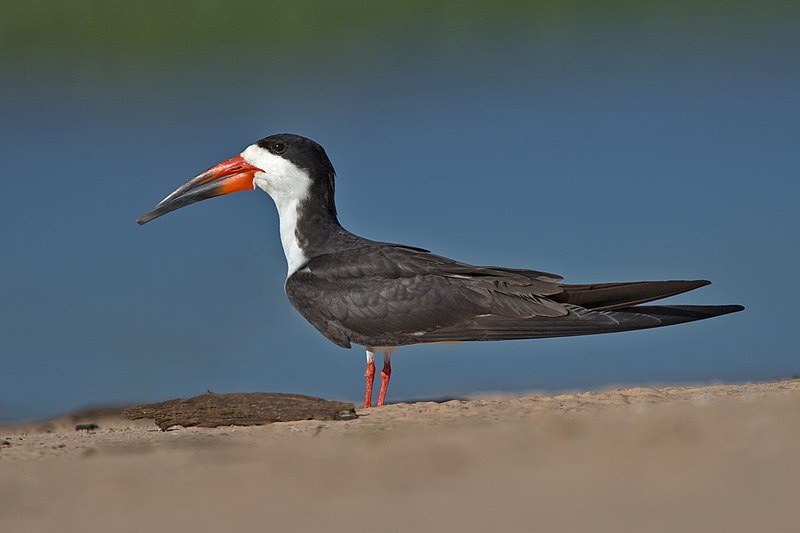
The Black Skimmer is a seabird which belongs to the skimmer genus Rynchops and Laridae family.
It breeds in North and South America, while Northern populations migrate south for winter towards warmer climates such as the Caribbean or Pacific coasts.
The Southern American races have adapted to annual floods by making shorter migrations during this time.
These birds are easily identified with their unique long red bill that has an upper mandible longer than its lower mandible.
They feed mainly on small fish caught at night when they skim across shallow water using their beak like a knife cutting through waves of water.
Their dark grey back contrasts against white belly feathers creating beautiful patterns in flight, aiding them in catching prey easier due to its camoflauge effect above and below waters surface.
Scientific classification:
| Kingdom | Animalia |
| Phylum | Chordata |
| Class | Aves |
| Order | Charadriiformes |
| Family | Laridae |
| Genus | Rynchops |
| Species | R. niger |
11. Yellow Oriole
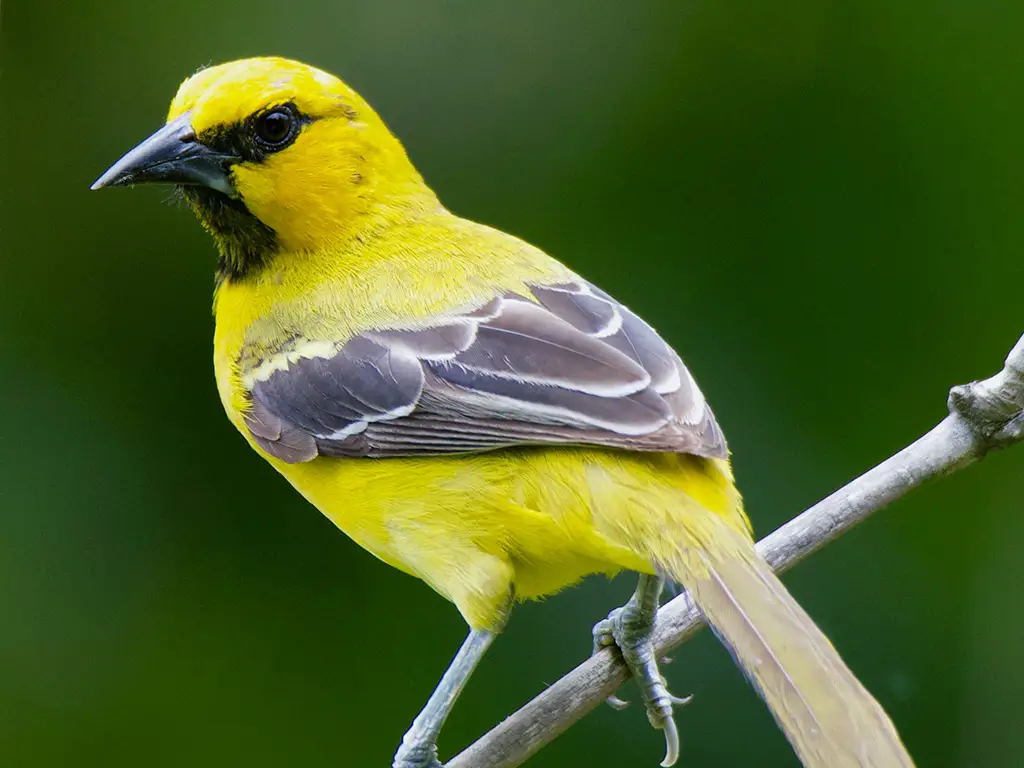
The Yellow Oriole is a beautiful passerine bird belonging to the Icteridae family. It has yellow feathers on its head, wings and back with black stripes running across them while it’s underparts are bright white in colour.
The adult male has an orange-yellow throat patch and females have grey throats.
They can be found breeding in northern South America where they inhabit dense woodland areas and open savanna habitats close to rivers or lakes.
Known as the Plantain Bird or Small Corn Bird by locals, these birds feed mainly on insects but will also consume fruits such as plantains and small corn grains for their diet. In Venezuela they’re known affectionately as ‘Gonzalito’.
A truly stunning species of wildlife worth keeping an eye out for when travelling through South America.
Scientific classification:
| Kingdom | Animalia |
| Phylum | Chordata |
| Class | Aves |
| Order | Passeriformes |
| Family | Icteridae |
| Genus | Icterus |
| Species | I. nigrogularis |
12. Common Ground Dove
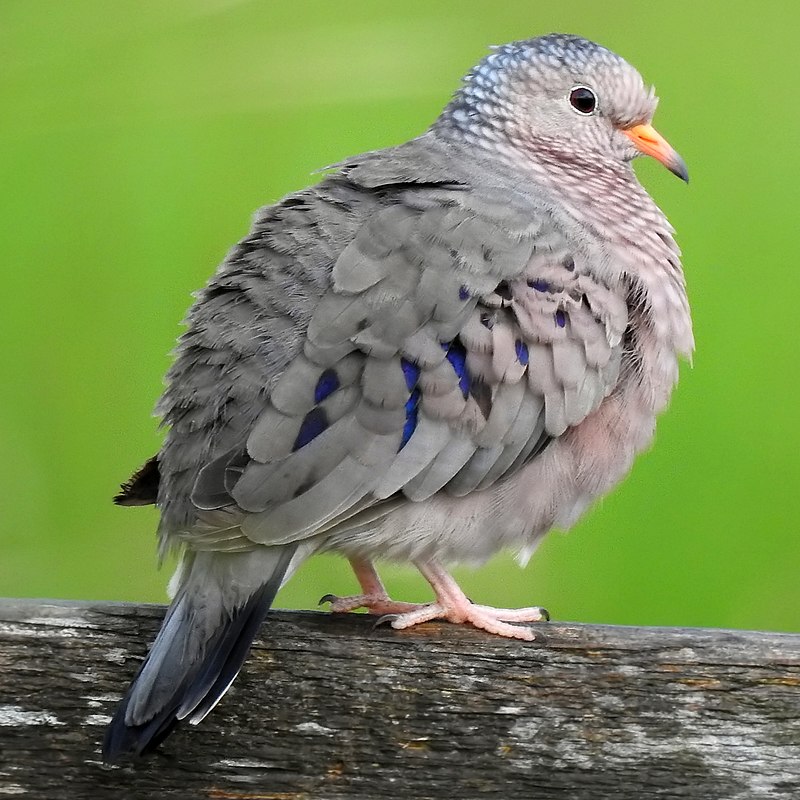
The Common Ground Dove is a small bird that can be found in the southern United States, Central America, the Caribbean and northern South America.
It’s considered to be one of the smallest dove species in North American with an average length of around 6–7 inches.
This ground-dwelling species spends most of its time on foot but has been known to fly when necessary or threatened.
The plumage is pale grayish brown above while their bellies are white and speckled with black spots along their wings.
Its diet consists mainly of seeds from grasses and other low vegetation which it forages for by walking slowly across open fields or lawns looking for food items like berries, grains, insects, spiders and snails.
Scientific classification:
| Kingdom | Animalia |
| Phylum | Chordata |
| Class | Aves |
| Order | Columbiformes |
| Family | Columbidae |
| Genus | Columbina |
| Species | C. passerina |
13. Gray Kingbird
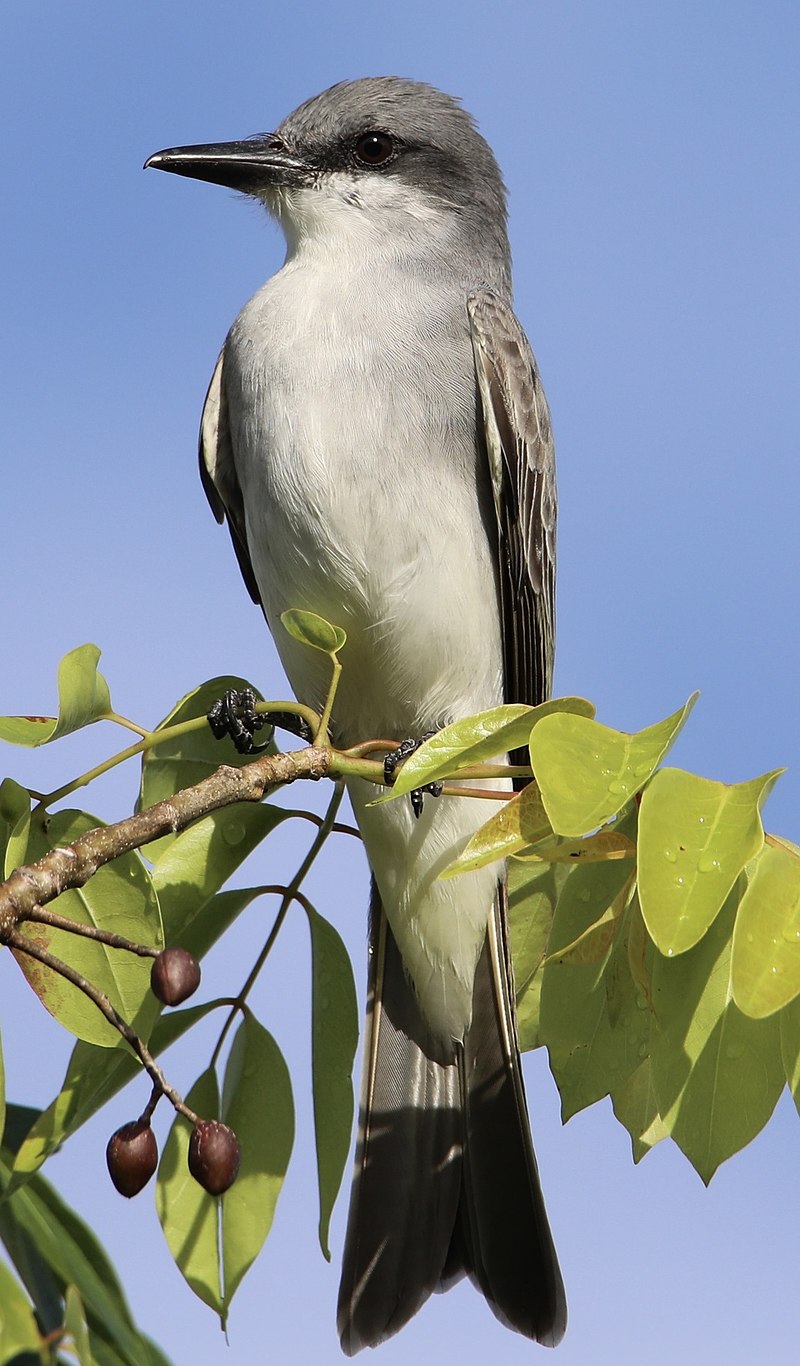
The Gray Kingbird is a species of tyrant flycatcher found in tall trees and shrubs, including the edges of savannas and marshes. It has gray feathers on its back with white underparts and blackish wings.
Its head is dark gray-brown or olive, while its tail is tipped with white. The Gray Kingbird builds flimsy cup nests from twigs in tree branches for their eggs to incubate safely until they hatch into chicks.
They feed mainly on insects such as moths, grasshoppers, beetles, crickets and caterpillars that can be caught midair when it swoops down from above like other kingbirds do.
This bird’s call consists of loud chirps which are often heard during mating season – making them an easily identifiable species within areas where they live.
Scientific classification:
| Kingdom | Animalia |
| Phylum | Chordata |
| Class | Aves |
| Order | Passeriformes |
| Family | Tyrannidae |
| Genus | Tyrannus |
| Species | T. dominicensis |
14. Least Tern
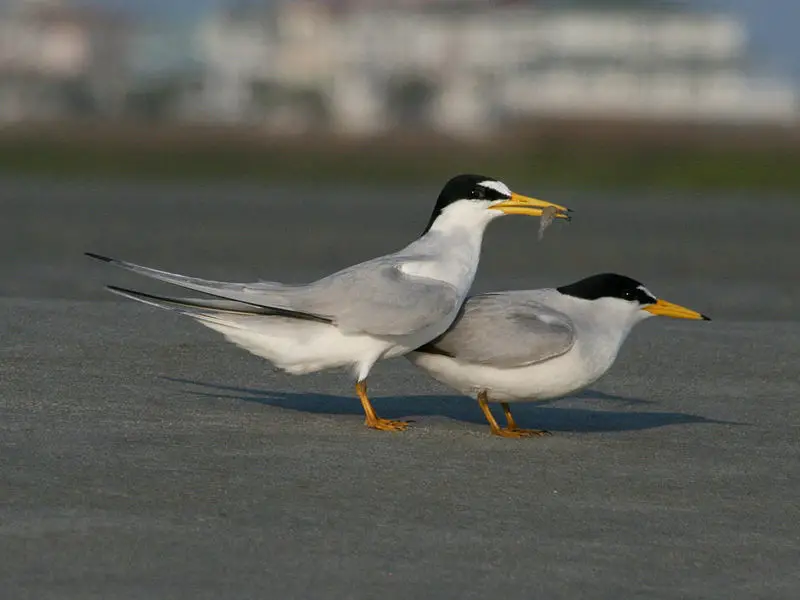
The Least Tern is a species of tern native to North America and northern South America. It has many close relatives, such as the yellow-billed tern and Peruvian tern from South America, or the little tern from the Old World.
The bird measures 8.7 – 9.4 inches in length with a wingspan of 16–18 inches acrosss, making it an intermediate size between most other species of birds within its family groupings.
Its feathers are usually gray on top with white underneath and typically have darker accents near their heads along with bright red bills for feeding during summer months when they mate upon beaches found throughout these regions mentioned above.
They feed mainly on small fish that live at shallow depths near shorelines where they also nest nearby due to migratory patterns which take place annually each year.
Hence why this particular bird does not travel far distances away from areas known as home for them over long periods of time like some other types do.
Scientific classification:
| Kingdom | Animalia |
| Phylum | Chordata |
| Class | Aves |
| Order | Charadriiformes |
| Family | Laridae |
| Genus | Sternula |
| Species | S. antillarum |
Also Featured In: Most Common Birds in South America Birds, Long Island Birds You Should Know
15. Icterids
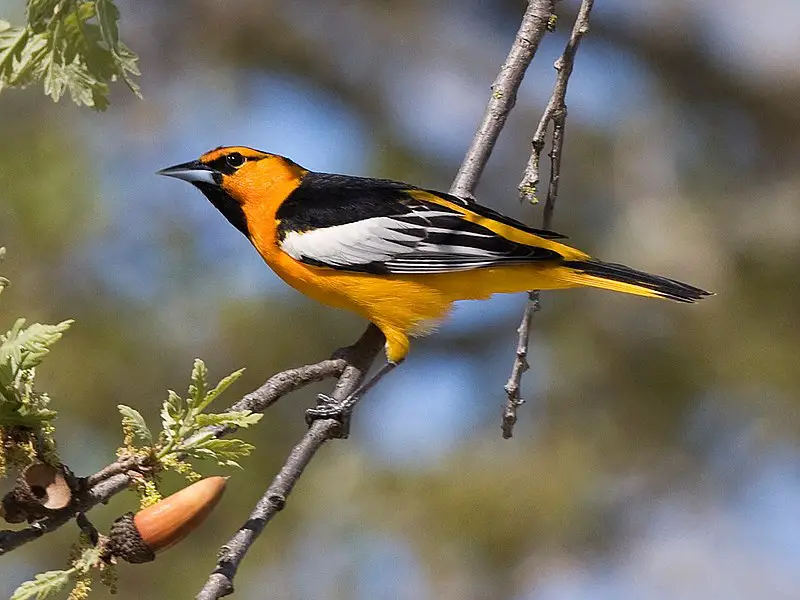
Icterids are a family of small to medium-sized, often colorful New World passerine birds. They have black as their predominant plumage color with yellow, orange or red adding vibrancy and life.
Their sizes range greatly in shape and behavior making them unique amongst other bird species.
The name Icterid comes from the Latin word ‘ictericus’ which means jaundiced ones – referring to the prominent yellow coloring found on some of these birds’ feathers.
These beautiful creatures can be seen flying around many different parts of South America where they live with their young for most part of the year before migrating northwards during fall season.
Scientific classification:
| Kingdom | Animalia |
| Phylum | Chordata |
| Class | Aves |
| Order | Passeriformes |
| Superfamily | Emberizoidea |
| Family | Icteridae Vigors, 1825 |
16. New World Quail
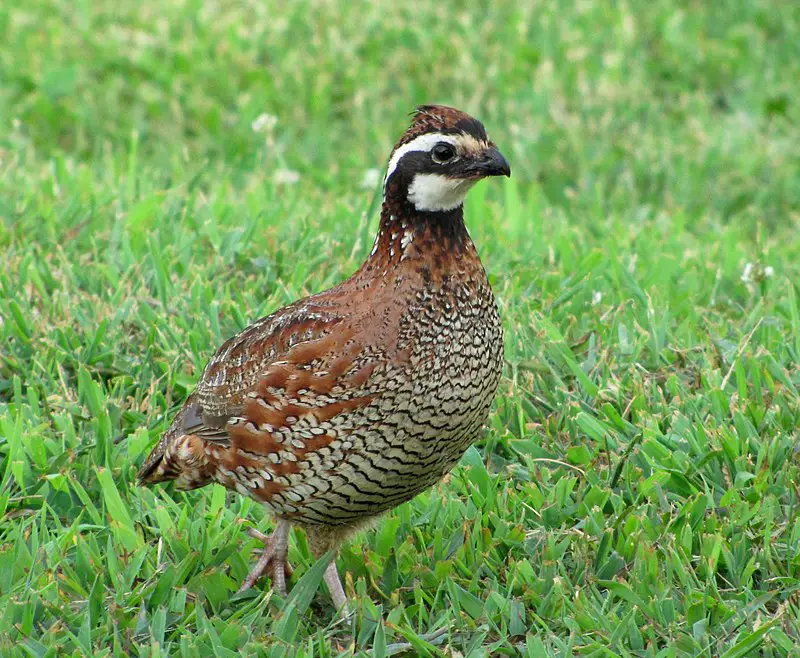
New World quail are small birds found in the Americas, from Canada to Brazil. They belong to their own family, Odontophoridae, and have similar appearance and habits as Old World quail which belong to a different family.
New World Quails come in various species such as California Quail and Bobwhite Quail.
These birds have adapted well to human presence due to availability of food resources like agricultural crops.
They also live close together where they form large flocks for safety against predators like foxes or hawks.
The males usually sport colorful feathers during mating season that helps them attract female mates while providing an amazing sight for us viewers.
Scientific classification:
| Kingdom | Animalia |
| Phylum | Chordata |
| Class | Aves |
| Order | Galliformes |
| Superfamily | Phasianoidea |
| Family | Odontophoridae Gould, 1844 |
17. Tyrant Flycatchers
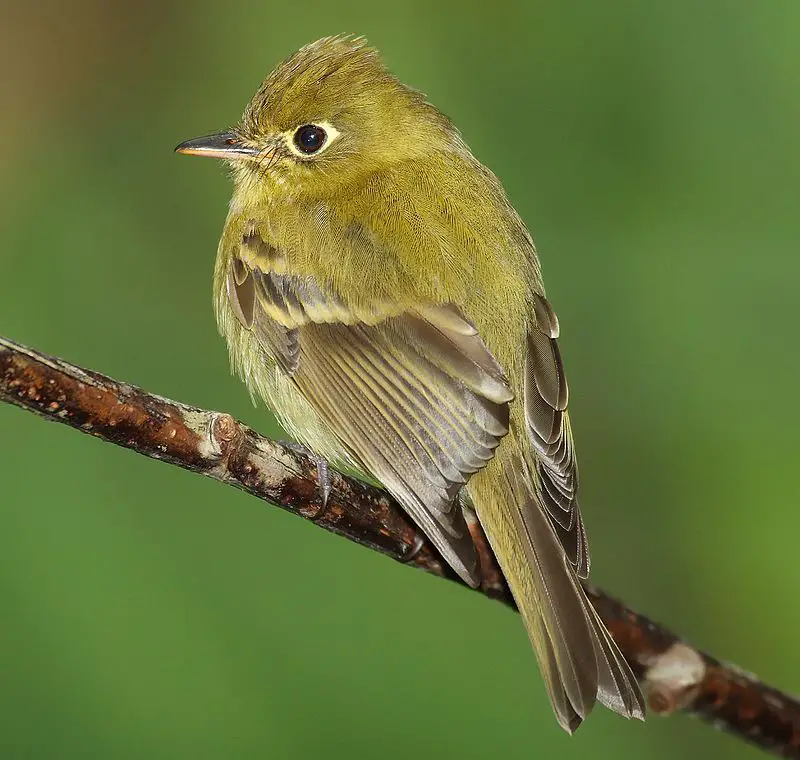
Tyrant flycatchers are a family of birds found in North and South America, containing over 400 species. These birds come in an array of shapes and sizes, with vibrant plumage to match.
They�re the most diverse avian family across all countries they inhabit except for the United States and Canada.
Their diet consists mainly of insects but also includes small reptiles or amphibians where available.
The behavior varies between each bird; some prefer open areas while others like dense forests as their habitat � many even migrate regularly.
Tyrant Flycatchers have adapted well to human presence thanks to the abundance of food sources that often accompany it � such as backyards, parks etc..
All things considered these incredible creatures are truly amazing.
Scientific classification:
| Kingdom | Animalia |
| Phylum | Chordata |
| Class | Aves |
| Order | Passeriformes |
| Parvorder | Tyrannida |
| Family | Tyrannidae Vigors, 1825 |
18. White-Cheeked Pintail
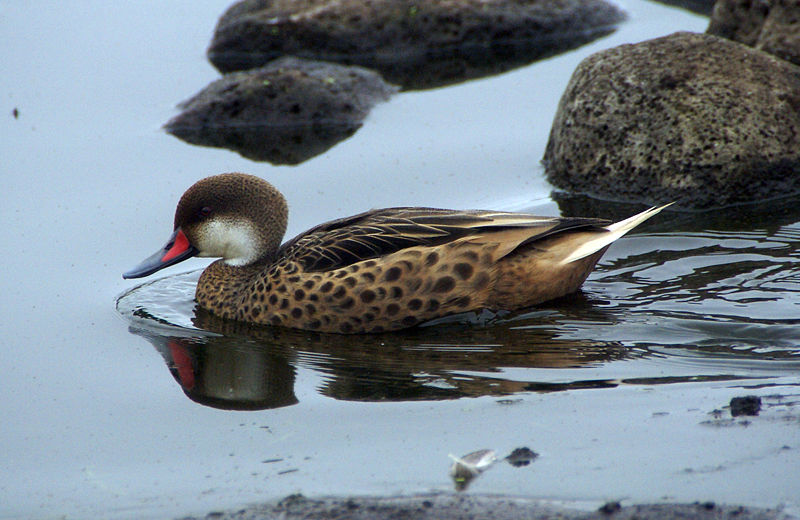
The white-cheeked pintail is a species of dabbling duck first described by Carl Linnaeus in 1758. This beautiful bird can be found mainly in the Caribbean, South America, and Galápagos Islands.
It prefers to inhabit brackish lakes or other waters with some salinity where it swims gracefully amongst its environment.
White-cheeked pintails have striking brown plumage on their back which contrasts beautifully against their white cheeks and bellies.
They also possess an elongated tail that aids them during flight as well as helping them attract potential mates while they are courting.
These birds feed primarily on aquatic invertebrates but may also consume small fish or plant material if available.
The conservation status of the white-cheeked pintail is currently considered “Least Concern” due to its wide distribution range and stable population numbers across much of its native habitat range.
Scientific classification:
| Kingdom | Animalia |
| Phylum | Chordata |
| Class | Aves |
| Order | Anseriformes |
| Family | Anatidae |
| Genus | Anas |
| Species | A. bahamensis |
19. Caribbean Elaenia
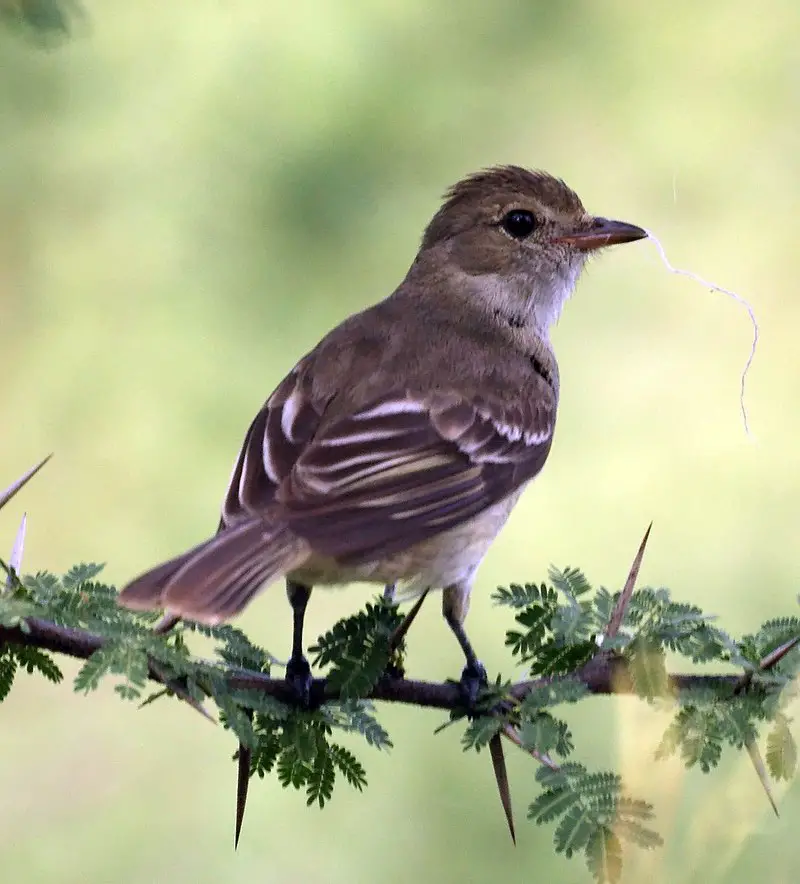
The Caribbean elaenia is a species of small bird that can be found in the West Indies and parts of Central America.
It is part of the Tyrannidae family and inhabits tropical dry broadleaf forests, subtropical or tropical moist lowland forests, as well as heavily degraded former forest areas.
In 1760, French zoologist Mathurin Jacques Brisson provided an extensive description on this species which has helped us gain further knowledge about it today.
The Caribbean elaenia typically measures around 6-9 inches long with predominantly olive green feathers with yellowish edges to some wings and tails.
They have white throats but lack any distinctive markings on their chest unlike many other birds from its family.
This bird feeds primarily on insects such as grasshoppers collected from trees or bushes while also consuming fruit when available during certain times of year.
Scientific classification:
| Kingdom | Animalia |
| Phylum | Chordata |
| Class | Aves |
| Order | Passeriformes |
| Family | Tyrannidae |
| Genus | Elaenia |
| Species | E. martinica |
20. Waxwing Birds
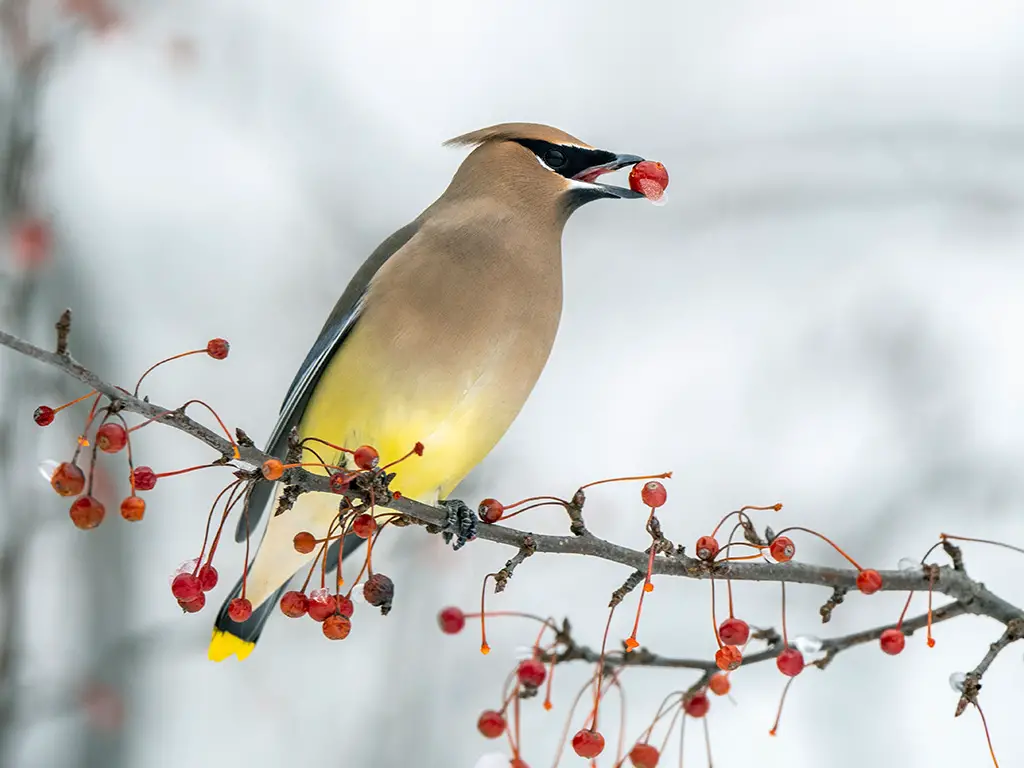
The Brown Pelican is a large seabird that can be found along the coastlines of North America. It has brown and white plumage, with long wings and a distinctive pouch under its bill for scooping up fish from the water’s surface.
The pelicans are quite social birds and often travel in flocks to feed together on small schools of fish.
They have an impressive wingspan which allows them to soar gracefully through the air, while their webbed feet help keep them afloat when they dive into the ocean below seeking food.
While these birds may look clumsy at times due to their size, they are actually very agile flyers who use their remarkable talents to capture prey quickly before returning back into flight again.
21. Mimid

Mimid birds are a diverse family of passerines found in the New World. They have an impressive vocal range and many species excel at mimicking other bird songs, as well as noises from their environment.
Mimids can be identified by their flat heads with short crest feathers, long tails, large eyes and strong legs for hopping between branches.
These birds typically inhabit open woodlands or scrubland areas where they feed on insects such as beetles, caterpillars and grasshoppers.
Some species also supplement their diet with fruits or grains when available. While most do not migrate far during winter months some may undertake longer migrations to warmer climates if necessary to survive cold weather spells.
The wide variety of sounds these talented singers produce make them one of nature’s great musical performers.
Scientific classification:
| Kingdom | Animalia |
| Phylum | Chordata |
| Class | Aves |
| Order | Passeriformes |
| Superfamily | Muscicapoidea |
| Family | Mimidae Bonaparte, 1853 |
22. Vireonidae
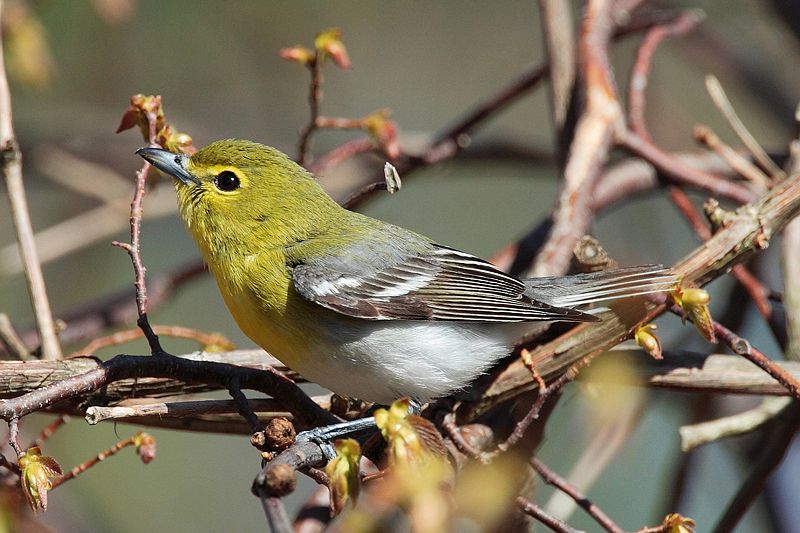
Vireonidae birds are a family of passerine birds found in the New World, Southeast Asia and other tropical regions.
They have dull plumage with greenish coloration and typically measure between small to medium sizes.
These migratory birds were so named by Latin referring to the female golden oriole or even European greenfinch.
Vireo species can be seen perching on branches while they feed mainly on insects such as caterpillars, beetles, grasshoppers and cicadas among others; some also eat fruits which provide them with essential nutrients for their diet.
As well as being known for their musical chirpings during mating season these colourful little creatures make wonderful additions to any garden.
Scientific classification:
| Kingdom | Animalia |
| Phylum | Chordata |
| Class | Aves |
| Order | Passeriformes |
| Superfamily | Orioloidea |
| Family | Vireonidae Swainson, 1837 |
23. Tanagers
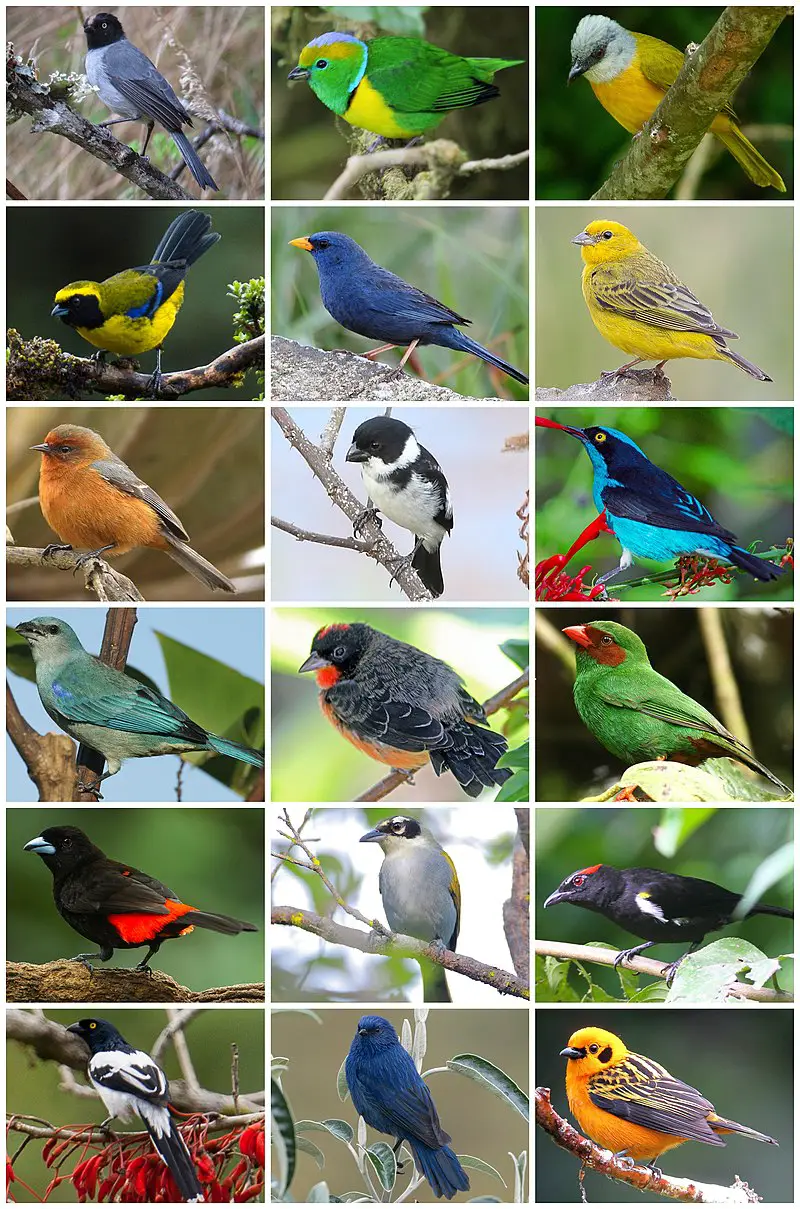
The Tanagers are a beautiful and diverse family of birds native to the Neotropical region. They boast an impressive array of colors, including blues, greens, yellows and reds.
The most common type is the fruit-eating tanager that can be found in tropical forests across Latin America. With nearly 240 species worldwide, they represent almost 4% of all avian species.
These vibrant birds have adapted well to their environment due to their strong bills used for cracking open hard fruits as well as sharp claws for gripping branches while feeding or perching.
As with many other bird families there is natural variation among populations making each one unique in its own way; something that makes them even more special.
Scientific classification:
| Kingdom | Animalia |
| Phylum | Chordata |
| Class | Aves |
| Order | Passeriformes |
| Superfamily | Emberizoidea |
| Family | Thraupidae Cabanis, 1847 |
24. Stilts And Avocets
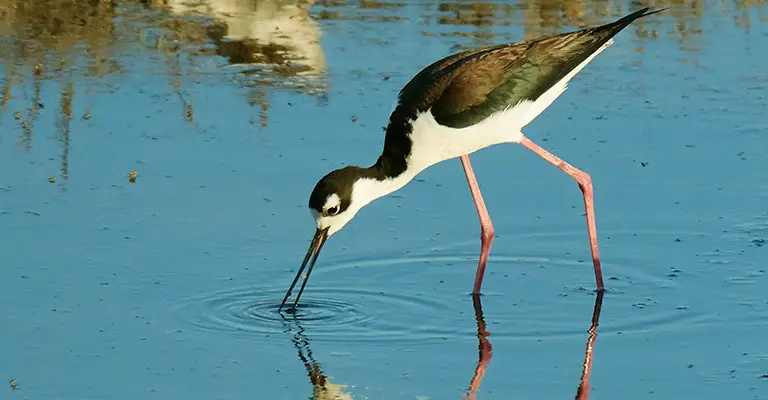
Stilts and avocets are two distinct groups of birds belonging to the family Recurvirostridae. They range in length from 30-46 cm (12-18 inches) and weigh between 140 – 435 g (4.9 – 15.3 ounces).
Males usually have slightly larger bodies than females, with long thin legs, necks and bills.
Avocet bills curve upwards uniquely while stilt beaks remain straight most times.
These wading birds live mainly near shorelines or wetlands where they feed on aquatic invertebrates like brine shrimp, insects etc., occasionally supplementing their diet with seeds or small fish too.
Stilts also inhabit open fields in search of food sources such as earthworms or grasshoppers during the non-breeding season.
Both groups migrate over large distances for warmer weathers when it gets cold outside.
Scientific classification:
| Kingdom | Animalia |
| Phylum | Chordata |
| Class | Aves |
| Order | Charadriiformes |
| Suborder | Charadrii |
| Family | Recurvirostridae Bonaparte, 1854 |
25. Bare-Eyed Pigeon
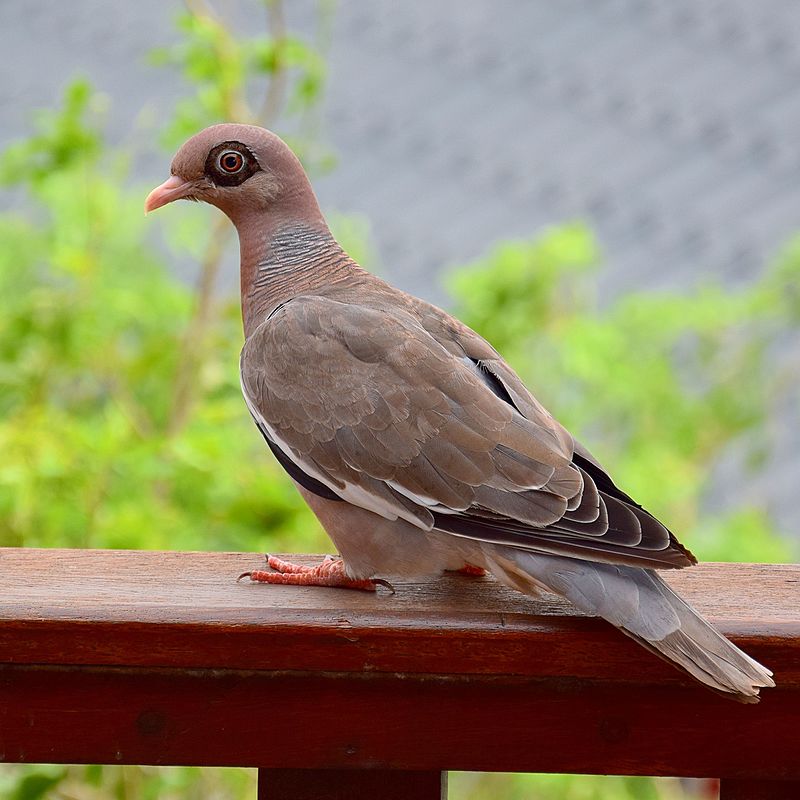
The Bare-eyed pigeon is a species of bird found in Colombia, Venezuela and the Netherlands Antilles.
It belongs to the family Columbidae and has been accepted by some authors that its plumage similarities with Picazuro Pigeon (P. picazuro), Spot-winged Pigeon (P. maculosa) and Scaled Pigeon (P. speciosa) make them part of one monophyletic group.
Others argue that significant differences between these birds exist, including vocalization patterns, flight behaviour as well as their habitat preferences which suggest they may not be closely related after all.
The Bare-eyed pigeon’s body measures up to 33 cm long with grayish brown feathers on top while being white underneath; it also has distinctive red eyespots near its bill base which give this species its unique name.
Scientific classification:
| Kingdom | Animalia |
| Phylum | Chordata |
| Class | Aves |
| Order | Columbiformes |
| Family | Columbidae |
| Genus | Patagioenas |
| Species | P. corensis |
Also Featured In: Winged Marvels of St Martin’s: A Bird Enthusiast’s Delight,
26. Royal Tern
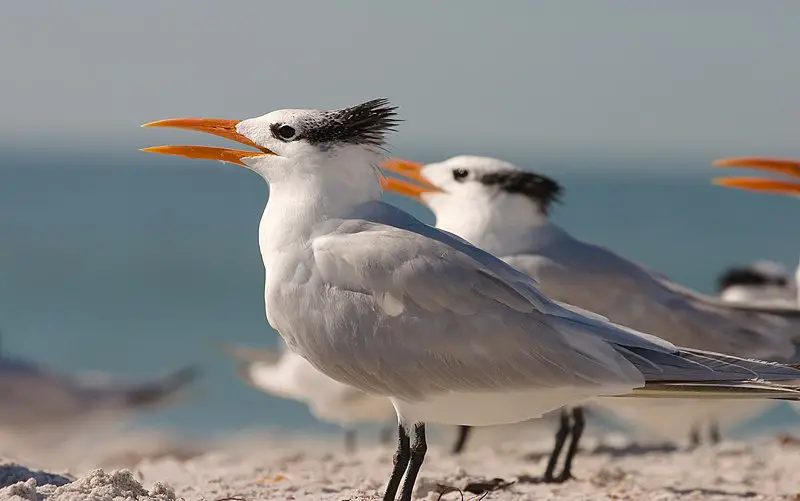
The Royal Tern is a beautiful seabird, endemic to the Americas. It has been spotted as far away as Europe on rare occasions though.
The species was first described by Georges-Louis Leclerc in 1781 from a specimen found in French Guiana and later illustrated with hand-coloured plates.
These birds have elaborate courtship displays that involve loud vocalizations and energetic aerial acrobatics.
They typically mate for life, nesting together near marshes or beaches each season close to their food source of fish and other small aquatic creatures. Their white plumage brightens up coastlines across America – they are truly majestic.
Scientific classification:
| Kingdom | Animalia |
| Phylum | Chordata |
| Class | Aves |
| Order | Charadriiformes |
| Family | Laridae |
| Genus | Thalasseus |
| Species | T. maximus |
27. Tropical Mockingbird
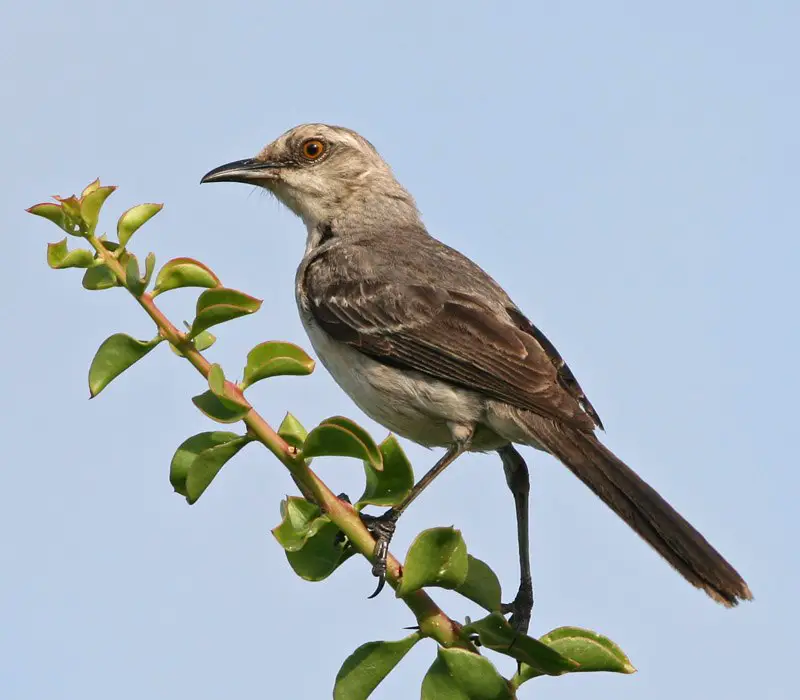
The Tropical mockingbird is a species of bird found throughout Central America and the Caribbean. It has been classified as a resident breeding bird, with its range stretching from southern Mexico to northern and eastern South America.
This species is closely related to the Northern Mockingbird, forming what is known as a superspecies between them both.
The Tropical mockingbird can be recognized by its grey-brown coloration on top, blending into white underparts which are highlighted by black spots along their throat and wings.
They have long legs for perching in trees or shrubs while searching for prey such as insects before singing out melodic songs during territorial disputes with other birds in the area.
Sadly, one subspecies -the San Cristobal Mockingbird – has been listed as critically endangered due to habitat destruction caused by human activities including logging within their natural environment.
Scientific classification:
| Kingdom | Animalia |
| Phylum | Chordata |
| Class | Aves |
| Order | Passeriformes |
| Family | Mimidae |
| Genus | Mimus |
| Species | M. gilvus |
28. Black-Faced Grassquit
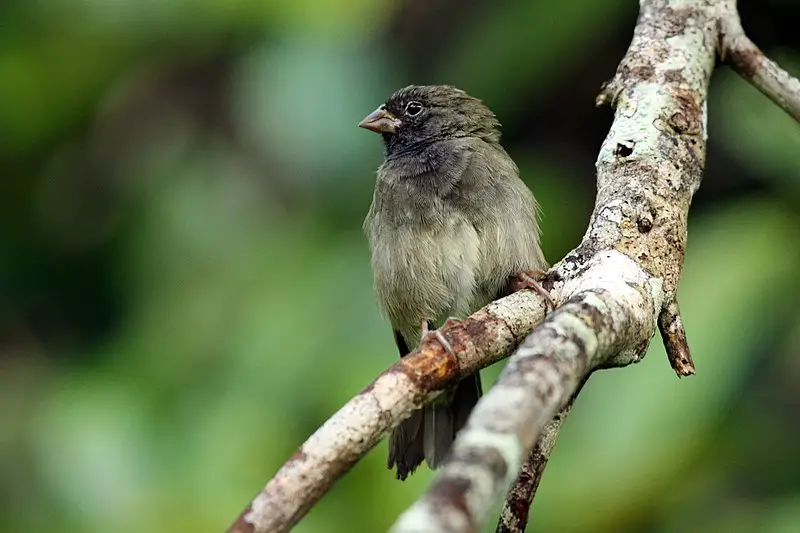
The Black-faced grassquit is a small bird belonging to the tanager family, genetically related to Darwin’s finches. It breeds mainly in the West Indies and along certain parts of Colombia and Venezuela.
The Swedish naturalist Carl Linnaeus first formally described it back in 1766 as part of his twelfth edition work on species classification.
This type of bird has a black head with white spots around its eyes, grey wings and tail feathers; its body is brownish orange or yellow with darker shades towards the belly area.
Its diet consists mostly of seeds from grasses but may also include other insects for additional nutrition during breeding season.
Scientific classification:
| Kingdom | Animalia |
| Phylum | Chordata |
| Class | Aves |
| Order | Passeriformes |
| Family | Thraupidae |
| Genus | Melanospiza |
| Species | M. bicolor |
29. Black-Whiskered Vireo
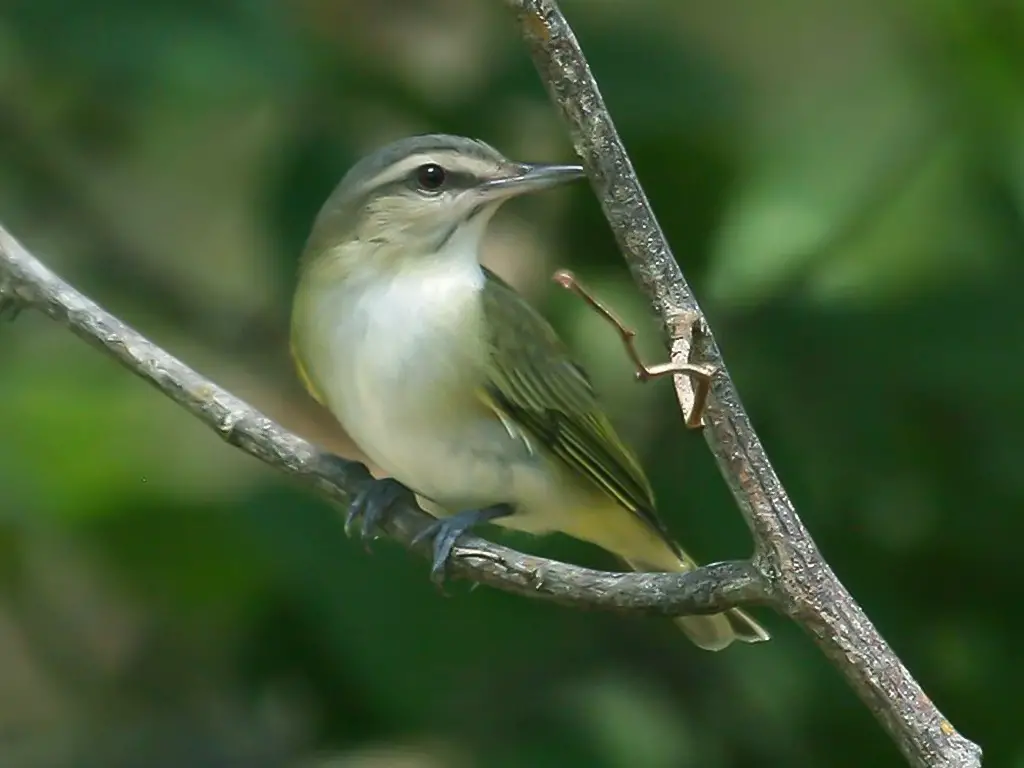
The black-whiskered vireo is a small passerine bird, found in the southern United States, West Indies and northern South America.
It breeds mainly in open deciduous wooded areas but has been known to be an occasional vagrant to Costa Rica.
This species migrates partially north during its winter season from Greater Antilles up towards northern parts of South America.
The male can easily be identified by his distinctive black whiskers on either side of its face while females are generally duller with white streaks along their wings and back.
They make nests at mid tree levels usually out of twigs, grasses or strips of bark which they line with finer materials like feathers or fur for insulation purposes.
All in all these birds are delightful additions to any habitat where they inhabit.
Scientific classification:
| Kingdom | Animalia |
| Phylum | Chordata |
| Class | Aves |
| Order | Passeriformes |
| Family | Vireonidae |
| Genus | Vireo |
| Species | V. altiloquus |
30. Magnificent Frigatebird
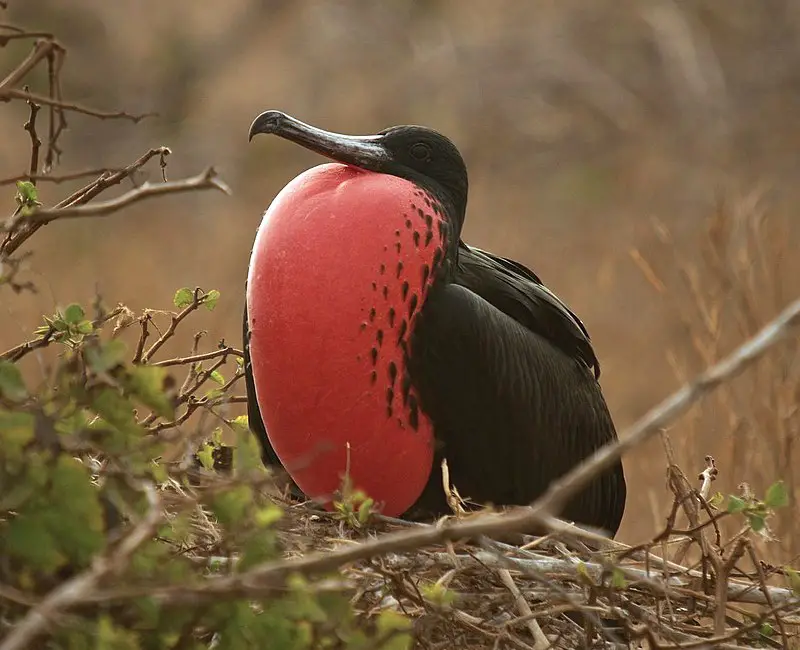
The Magnificent Frigatebird is the largest species of frigatebird, measuring between 89 and 114 cm in length and having a wingspan of 7-8 ft.
It can be found over tropical waters off America from northern Mexico to Peru on the Pacific coast, as well as Florida down south.
Its diet consists mainly of fish they take from other seabirds or snatch directly from the ocean surface while flying low above it.
They also feed on crustaceans and squid when available too.
This impressive bird has an unmistakable silhouette with its long pointed wings, forked tail feathers and male’s red gular pouch which inflates during courtship displays.
Scientific classification:
| Kingdom | Animalia |
| Phylum | Chordata |
| Class | Aves |
| Order | Suliformes |
| Family | Fregatidae |
| Genus | Fregata |
| Species | F. magnificens |
31. Scaly-Naped Pigeon
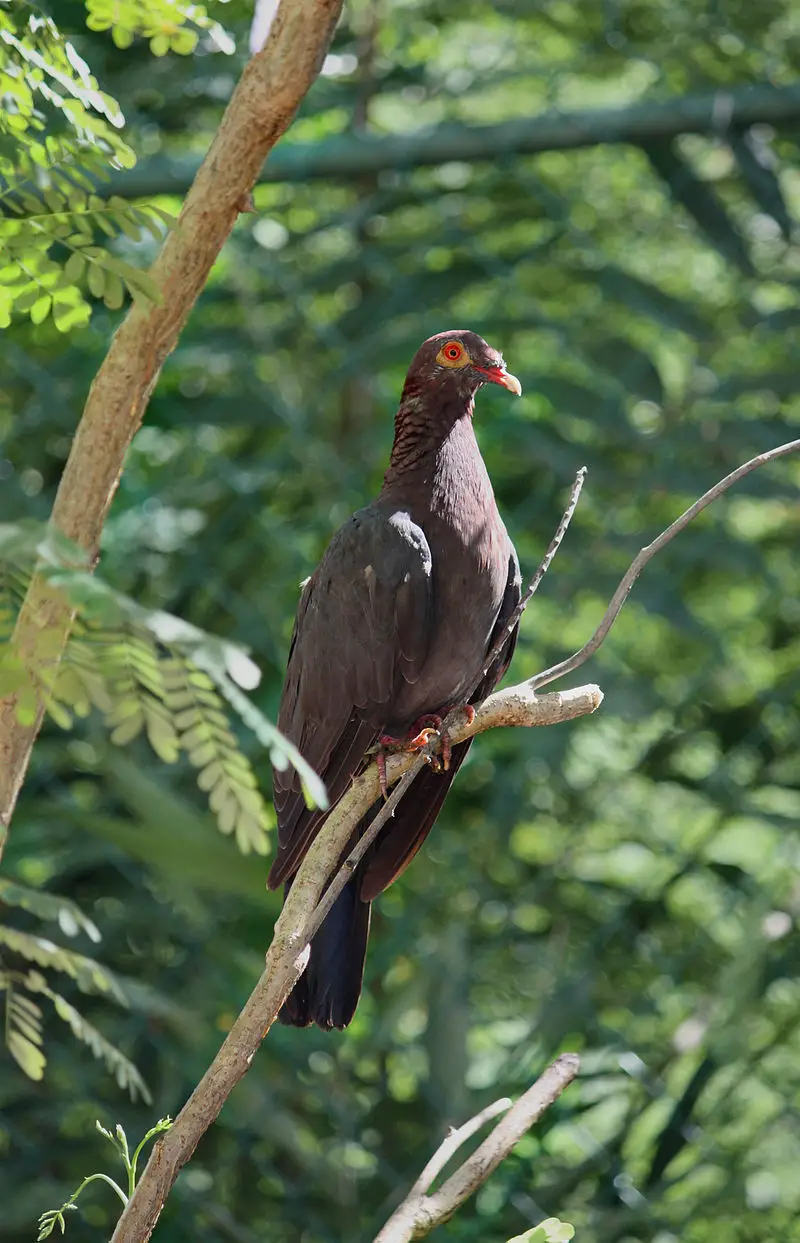
The scaly-naped pigeon is a large bird belonging to the family Columbidae. It has slate grey plumage with maroon coloured feathers around its neck, giving it the common name of red-necked pigeon.
The species originates from throughout the Caribbean and can reach 14–16 inches in length.
Its scientific name is derived from its unique feature: small scales on its nape which form an attractive pattern when viewed up close.
This makes them easily distinguishable from other birds within their range as they are one of few that have this characteristic.
They feed mainly on fruit but also consume seeds, insects and even carrion depending on availability at any given time of year or location.
Scientific classification:
| Kingdom | Animalia |
| Phylum | Chordata |
| Class | Aves |
| Order | Columbiformes |
| Family | Columbidae |
| Genus | Patagioenas |
| Species | P. squamosa |
32. Eared Dove
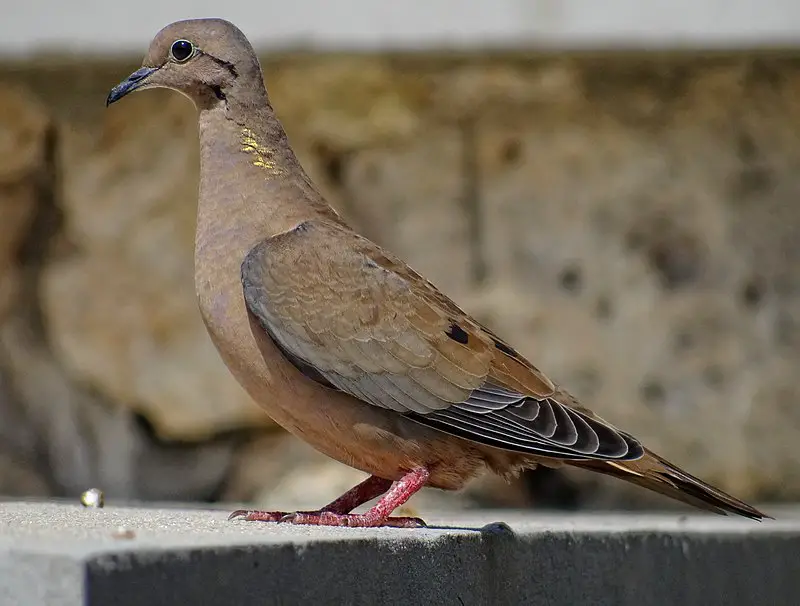
The Eared Dove is a beautiful bird that can be found throughout South America, ranging from Colombia to Argentina and Chile. It has also been spotted in Trinidad and Tobago recently.
This species tends to be partially migratory depending on food supplies available in the area, making it an important part of the local environment.
Its plumage tends to vary by region with some individuals having brighter colors than others where they are found near forested areas or along coasts.
The most recognizable feature of this dove is its ear tufts which gives it its common name – Eared Dove.
These doves have a soft cooing sound as their call which makes them truly unique among other birds in their range.
Scientific classification:
| Kingdom | Animalia |
| Phylum | Chordata |
| Class | Aves |
| Order | Columbiformes |
| Family | Columbidae |
| Genus | Zenaida |
| Species | Z. auriculata |
33. Pelecaniformes
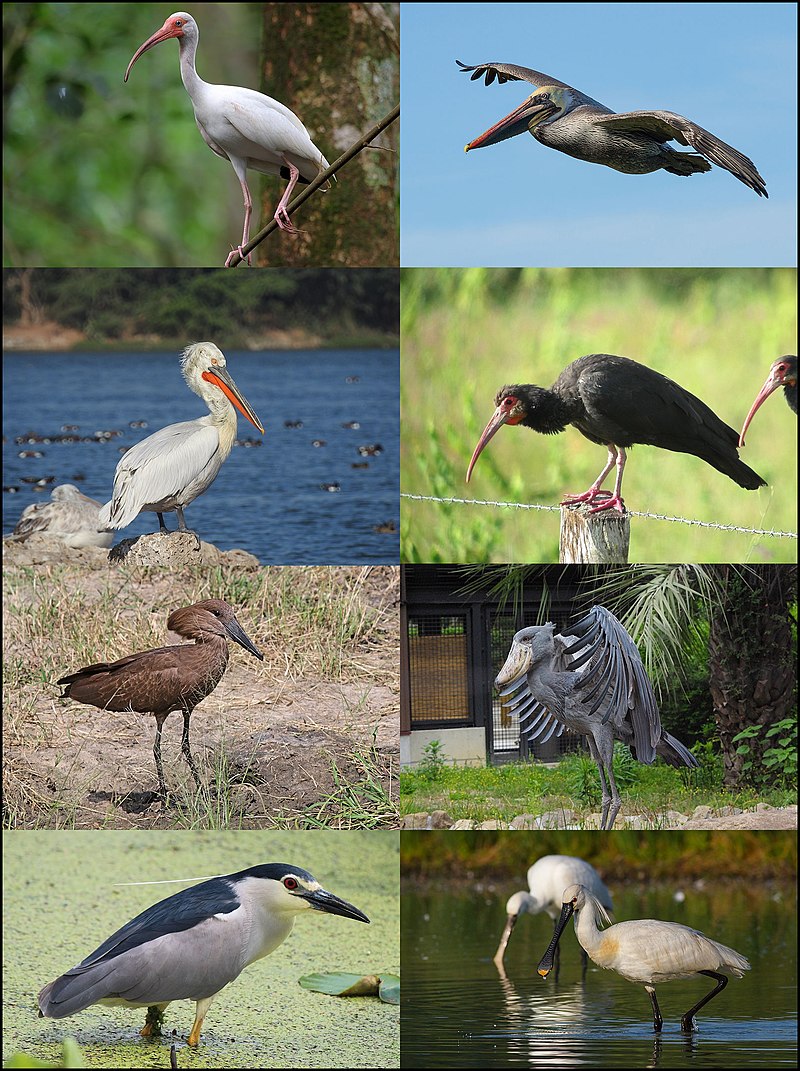
Pelecaniformes are a diverse order of waterbirds found all around the world. They vary in size, but most species are medium to large birds with webbed feet and a bare throat patch (gular patch).
Their nostrils have evolved into non-functional slits. Some examples include pelicans, gannets, cormorants and frigatebirds which can be found near coasts or on inland waters such as lakes or rivers.
Many Pelecaniforms fish for food by diving underwater from the air – some even swim underwater.
The diet of these birds consists mainly of small fishes although they may also eat mollusks, crustaceans and other aquatic creatures depending on their location.
All in all, Pelecaniformes make an important contribution to our planet’s biodiversity by keeping populations of fish under control while providing us with great views when we’re out exploring nature.
Scientific classification:
| Kingdom | Animalia |
| Phylum | Chordata |
| Class | Aves |
| Clade | Aequornithes |
| Order | Pelecaniformes Sharpe, 1891 |
34. Apodiformes
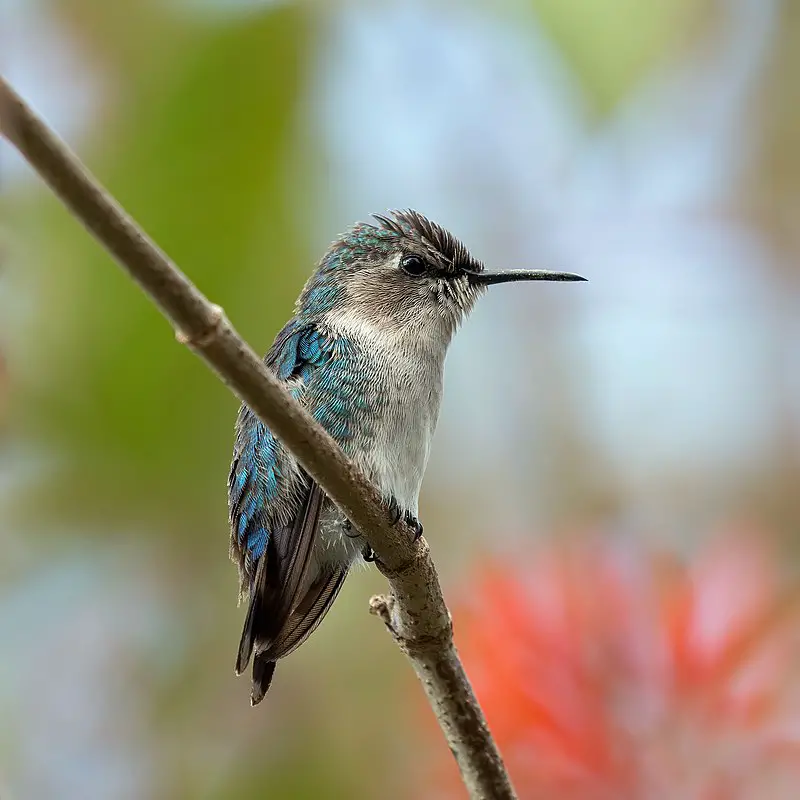
Apodiformes is a bird order consisting of three families: Apodidae, Hemiprocnidae and Trochilidae. With nearly 450 species identified to date, they are the most diverse of any avian group.
They range in size from tiny hummingbirds (Trochilidae) to larger swifts (Apodidae).
The majority of them feed on small insects or nectar from flowers and can fly for extended periods without rest due to their unique physiology; many have long wings which allow them to soar through the air with minimal effort.
Treeswifts (Hemiprocnidsae) inhabit tropical forests where they use their wide-spanning gliding flight pattern as an advantage when hunting prey such as beetles and moths.
These birds form some remarkable migratory patterns too.
Scientific classification:
| Kingdom | Animalia |
| Phylum | Chordata |
| Class | Aves |
| Clade | Daedalornithes |
| Order | Apodiformes Peters, 1940 |
Also Featured In: Syrian Birds You Need to Know, Bulgarian Birds
35. Petrels
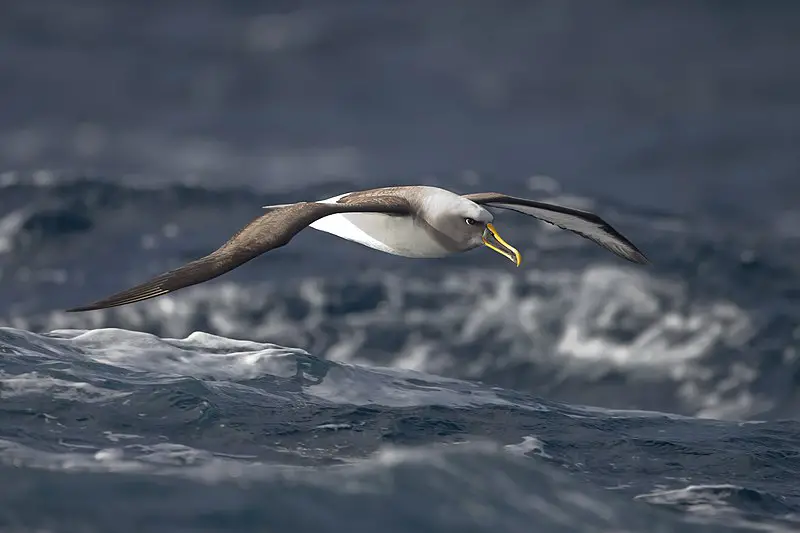
Petrels are seabirds that belong to the Procellariiformes order. They come from four families: albatrosses, petrels and shearwaters, as well as two storm petrel families.
Commonly referred to collectively as ‘petrels’, these birds have a long history of being called Tubinares or tubenoses – referring to their distinctive beaks which feature small tubes on either side for them to detect food in dark seawater.
Petrels mainly consume fish, squid and other small marine creatures, but they also feed off carrion when needed.
These waterbirds can fly great distances over open oceans in search of food with no land insight.
Scientific classification:
| Kingdom | Animalia |
| Phylum | Chordata |
| Class | Aves |
| Clade | Austrodyptornithes |
| Order | Procellariiformes Fürbringer, 1888 |
36. Gannets
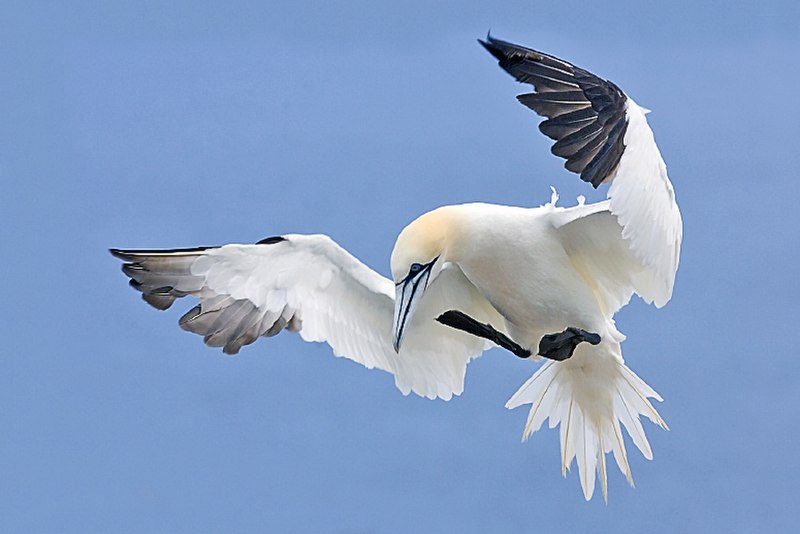
Gannets are large seabirds belonging to the Suliformes Order. They typically have a white plumage, webbed feet and long pointed wings.
Their most distinctive feature is their bright yellow-tipped beak which they use to catch fish in the sea.
Gannets can dive up to 30 metres deep into the water after prey and travel hundreds of miles at speeds of up to 40mph while fishing.
Despite being incredibly fast flyers, gannets spend much of their time atop cliffs or on shallow ledges where they form colonies that contain thousands of nesting birds from all over the world.
In addition, these birds feed not only themselves but also other species such as cormorants who follow them around for scraps left behind by gannet parents feeding chicks – an amazing display of generosity.
Scientific classification:
| Kingdom | Animalia |
| Phylum | Chordata |
| Class | Aves |
| Clade | Aequornithes |
| Order | Suliformes Sharpe, 1891 |
37. Black-Capped Petrel
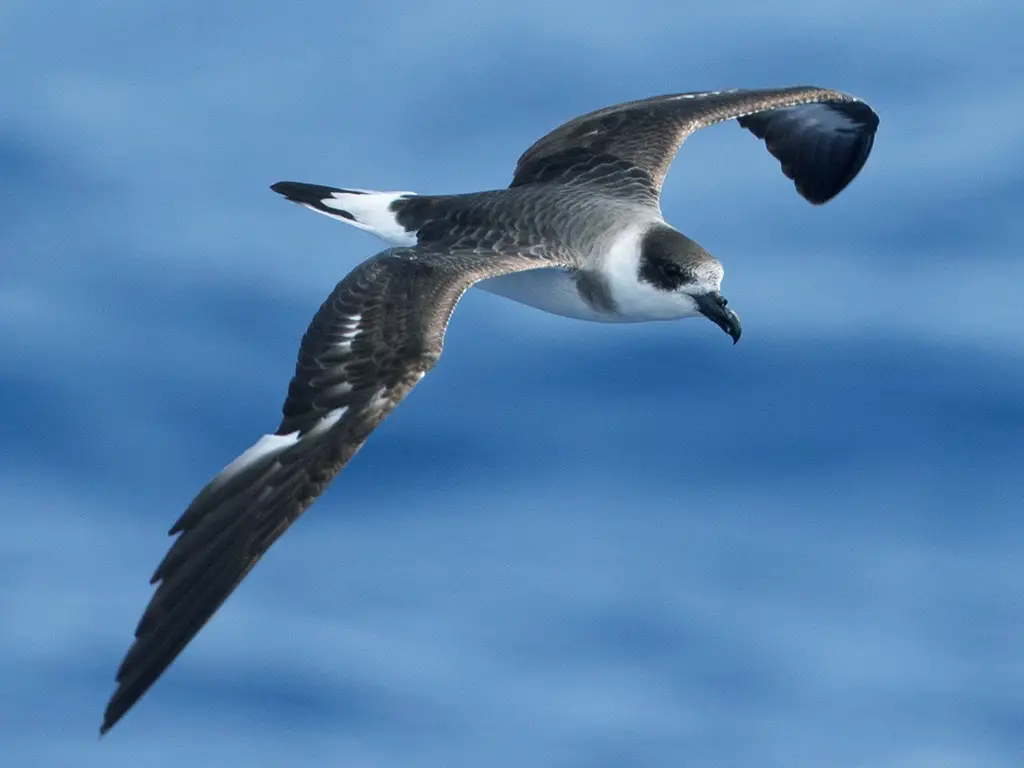
The Black-capped Petrel is a small seabird native to the West Indies. It has grey-brown back and wings, with a white nape and rump.
Its distinct feature is its black cap which extends to cover the eye in some individuals.
They have mainly white underparts apart from dark underwing markings as well.
These birds typically feed on crustaceans, fish eggs, squid or jellyfish plucked out of water while flying low over it with their relatively long wingspan aiding them in flight efficiency and speed.
Breeding season occurs around July-September during which they inhabit rocky cliff ledges near the shorelines for nesting purposes where they lay one egg at a time per nest.
Scientific classification:
| Kingdom | Animalia |
| Phylum | Chordata |
| Class | Aves |
| Order | Procellariiformes |
| Family | Procellariidae |
| Genus | Pterodroma |
| Species | P. hasitata |